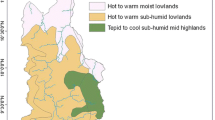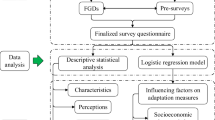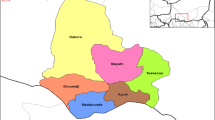Abstract
Climate change affects the productivity of agricultural ecosystems. Farmers cope with climate change based on their perceptions of changing climate patterns. Using a case study from the Middle Yarlung Zangbo River Valley, we present a new research framework that uses questionnaire and interview methods to compare local farmers’ perceptions of climate change with the adaptive farming strategies they adopt. Most farmers in the valley believed that temperatures had increased in the last 30 years but did not note any changes in precipitation. Most farmers also reported sowing and harvesting hulless barley 10–15 days earlier than they were 20 years ago. In addition, farmers observed that plants were flowering and river ice was melting earlier in the season, but they did not perceive changes in plant germination, herbaceous vegetation growth, or other spring seasonal events. Most farmers noticed an extended fall season signified by delays in the freezing of rivers and an extended growing season for grassland vegetation. The study results showed that agricultural practices in the study area are still traditional; that is, local farmers’ perceptions of climate change and their strategies to mitigate its impacts were based on indigenous knowledge and their own experiences. Adaptive strategies included adjusting planting and harvesting dates, changing crop species, and improving irrigation infrastructure. However, the farmers’ decisions could not be fully attributed to their concerns about climate change. Local farming systems exhibit high adaptability to climate variability. Additionally, off-farm income has reduced the dependence of the farmers on agriculture, and an agricultural subsidy from the Chinese Central Government has mitigated the farmers’ vulnerability. Nevertheless, it remains necessary for local farmers to build a system of adaptive climate change strategies that combines traditional experience and indigenous knowledge with scientific research and government polices as key factors.














Similar content being viewed by others
Notes
The data collected from Tibet Statistical Yearbook (1982–2011).
Data collected from: http://www.chinatibetnews.com/caijing/2009-04/09/content_227655.htm.
References
Adams RM, Hurd BH, Lenhart S et al (1998) Effects of global climate change on agriculture: an interpretative review. Clim Res 11:19–30
Adger WN, Dessai S, Goulden M et al (2009) Are there social limits to adaptation to climate change? Clim Change 93:335–354
Battaglini A, Barbeau G, Bindi M et al (2009) European winegrowers’ perceptions of climate change impact and options for adaptation. Reg Environ Change 9:61–73
Bell PA, Greene TC, Fisher JD et al (2001) Environmental psychology, 5th edn. Harcourt College Publisher, Fort Worth
Brondizio ES, Moran EF (2008) Human dimensions of climate change: the vulnerability of small farmers in the Amazon. Philos Trans Royal Soc B 363:1803–1809
Budyko MI, Menzhulin GV (1996) Climate change impacts on agriculture and global food production : options for adaptive strategies. Adapting to climate change. Springer, New York, pp 188–203
Byg A, Salick J (2009) Local perspectives on a global phenomenon-climate change in Eastern Tibetan villages. Glob Environ Change-Human Policy Dimens 19:156–166
Du MY, Kawashima S, Yonemura S et al (2004) Mutual influence between human activities and climate change in the Tibetan Plateau during recent years. Glob Planet Change 41:241–249
Fischer AM (2006) Subsistence capacity: the commodification of rural labor re-examined through the case of Tibet. Development Studies Institute, London School of Economics, London Working Paper Series
Goldstein MC, Childs G, Wangdui P (2008) Going for income in village Tibet. Asian Surv 48:514–534
Grothmann T, Patt A (2005) Adaptive capacity and human cognition: the process of individual adaptation to climate change. Glob Environ Change-Human Policy Dimens 15:199–213
Hu SJ (1995) An introduction to agriculture of Tibet. Sichuan Publishing House of Science and Technology, Chengdu, p 51 (in Chinese)
IPCC (2007) Climate Change 2007: Impacts, Adaptation and Vulnerability. Contribution of Working Group II to the Fourth Assessment Report of the Intergovernmental Panel on Climate Change, M.L. Parry, O.F. Canziani, J.P. Palutikof, P.J. van der Linden and C.E. Hanson, Eds., Cambridge University Press, Cambridge, UK
Liu J, Li X, Zhong XH (2004) Consumption structure of food and the countermeasure of grain in Tibet. J Mt Res 3:005 (in Chinese)
Liu Y, Bao Q, Duan A et al (2007) Recent progress in the impact of the Tibetan plateau on climate in China. Adv Atmos Sci 24:1060–1076
Mendelsohn R, Nordhaus WD, Shaw D (1994) The impact of global warming on agriculture: a Ricardian analysis. Am Econ Rev 84:753–771
Mertz O, Halsnæs K, Olesen J et al (2009a) Adaptation to climate change in developing countries. Environ Manage 43:743–752
Mertz O, Mbow C, Reenberg A et al (2009b) Farmers’ perceptions of climate change and agricultural adaptation strategies in rural Sahel. Environ Manage 43:804–816
Niu T, Chen LX, Zhou ZJ (2004) The characteristics of climate change over the Tibetan Plateau in the last 40 years and the detection of climatic jumps. Adv Atmos Sci 21:193–203
Nyima T, Tang YW, Zeng XQ (2012) Food Preparation from Hulless Barley in Tibet. Advance in Barley Sciences, Proceedings of 11th International Barley Genetics Symposium, pp 151–158
Paltridge N, Tao J, Wilkins J et al (2011) Farming systems in the Valleys of Central Tibet. Rainfed farming systems. Springer, Netherlands, pp 671–689
Piao S, Fang J, Zhou L et al (2006) Variations in satellite-derived phenology in China’s temperate vegetation. Glob Change Biol 12:672–685
Piao S, Ciais P, Huang Y et al (2010) The impacts of climate change on water resources and agriculture in China. Nature 467:43–51
Sonka ST, Patrick GF (1984) Risk management and decision making in agricultural firms. Risk management in agriculture. Iowa State University Press, Ames, pp 95–115
Stone JMR, Bhatti JS, Lal R (2006) Impacts of climate change on agriculture, forest, and wetland ecosystems: Synthesis and summary. Climate Change and Managed Ecosystems, pp 397–410
Temesgen M, Rockstrom J, Savenije HHG et al (2008) Determinants of tillage frequency among smallholder farmers in two semi-arid areas in Ethiopia. Phys Chem Earth Parts A/B/C 33:183–191
Thomas D, Twyman C, Osbahr H et al (2007) Adaptation to climate change and variability: farmer responses to intra-seasonal precipitation trends in South Africa. Clim Change 83:301–322
Vedwan N, Rhoades RE (2001) Climate change in the Western Himalayas of India: a study of local perception and response. Clim Res 19:109–117
Yang X, Lin E, Ma S et al (2007) Adaptation of agriculture to warming in Northeast China. Clim Change 84:45–58
Zhang YL, Li BY, Zheng D (2002) A discussion on the boundary and area of the Tibetan Plateau in China. Geogr Res 21:1–8 (in Chinese)
Zhao L, Ping CL, Yang D et al (2004) Changes of climate and seasonally frozen ground over the past 30 years in Qinghai-Xizang (Tibetan) Plateau, China. Glob Planet Change 43:19–31
Zhu W, Chen L, Zhou Z (2001) Several characteristics of contemporary climate change in the Tibetan Plateau. Sci China, Ser D Earth Sci 44:410–420
Acknowledgments
This study was supported by the National Key Basic Research Program: Respond Processes of Ecosystem and Social System in Tibetan Plateau to Climate Change and the Regional Adaptation (No. 2010CB951704) and Project 111 (B08037). Special thanks are given to the China Meteorological Data Sharing Service System for providing meteorological data and agricultural meteorological data and to the counties in the study area for assistance with the key informant interviews and data collection. The authors thank Professor Carla Bossard of Saint Mary’s College of California and Fulbright Scholar Mathhem Williams at Sichuan University for their assistance with language editing.
Author information
Authors and Affiliations
Corresponding author
Rights and permissions
About this article
Cite this article
Li, C., Tang, Y., Luo, H. et al. Local Farmers’ Perceptions of Climate Change and Local Adaptive Strategies: A Case Study from the Middle Yarlung Zangbo River Valley, Tibet, China. Environmental Management 52, 894–906 (2013). https://doi.org/10.1007/s00267-013-0139-0
Received:
Accepted:
Published:
Issue Date:
DOI: https://doi.org/10.1007/s00267-013-0139-0




